|
11. DECIMAL COINS |
During Victorian times there was movement towards the introduction of a decimal coinage. As a preliminary, the half crown ceased to be minted in 1850 and a new coin, the florin ,with a value of two shillings i.e. a tenth of a pound, took its place. Nevertheless, although the idea was finally abandoned and the half crown reintroduced in 1874, the florin continued to be minted. That the idea of decimalization still lingered is shown by the introduction of the double florin, one fifth of a pound, in 1887, but this coin proved unpopular and was discontinued after four years. At the time it was known as the "Barmaid's ruin" because it was so easily mistaken for the crown.
In 1961 a Committee of Enquiry was set up to consider again the adoption of a decimal currency. In its report, published in 1968, it recommended a currency still based on the pound, but divided into a hundred pennies. A minority of the committee favoured a currency based on ten shillings, with each shilling worth ten pence. In the new system the florin would be retained and become ten new pence and the shilling five new pence and all new coins minted would show these values. There would be three new bronze coins with values of a half, one and two new pence and a new fifty pence coin to replace the ten shilling note. The letter "d" to denote pence was to be replaced by "p", entering common parlance as "pee" or "new pee". Almost as an afterthought, the old sixpence was also retained with a value of two and a half new pence, but no more were to be minted. It eventually ceased to be legal tender in 1980. The new coinage was to become effective on 15 February 1971.
As a preliminary, the cupro-nickel florins and shillings minted from 1968 onwards showed their value in new pence. The distinctive seven-sided fifty pence coin entered circulation in October 1969 and the following year, the ten shilling note ceased to be printed though it still remained in circulation for some years afterwards. Production of all the old denominations ceased as the Royal Mint geared up in readiness for the changeover. However, in 1968, before ceasing completely, a large number of souvenir proof sets in the old currency were minted dated 1970 and specimen sets of the new coins, but dated 1971, were made available at the same time.
The introduction of decimalization in 1971 produced much confusion and anomalies. Dual pricing was allowed in order for people to adjust to the new coinage but this seemed to cause more problems than a quick changeover. Eventually a law was passed stating that all goods must be price only in new pence.
Commemorative crowns were still issued with a value of 25 new pence. These were to celebrate the Queen's 25th Wedding Anniversary in 1971, her Silver Jubilee in 1977, the Queen Mother's 80th birthday in 1980 and finally the wedding of Price Charles and Lady Diana Spencer in 1981. Thereafter, all new crowns were to be given a value of £5, although the first of these did not appear until 1990. None of these coins were intended for circulation but they do have legal tender status.
The decimal coinage remained unchanged until 1982 when a new seven-sided twenty pence coin was introduced. There had been considerable demand for such a coin for several years. At the same time the word "New" was dropped from the value shown on the reverse of all coins as it was considered that by now there would no longer be any confusion with the old coinage. The following year, the pound note was replaced with a brass coin due to inflation, which had made the printing of the notes uneconomic (they had a relatively short life and considerable security measures and controls had to be exercised in their printing). These brass coins make an interesting collection as each year the reverse design was changed, each reverse representing one of the nations that go to make up Britain. So far there have been at least ten different reverse types used.
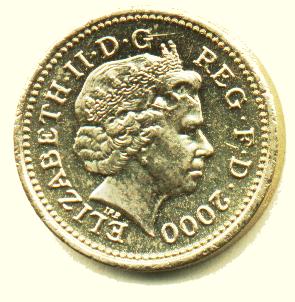
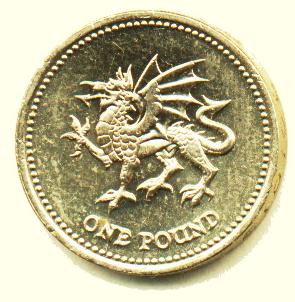
£1 coin of nickel-brass 2000 with reverse
depicting
a Welsh dragon
Inflation also caused the demise of the half pence, which was discontinued in 1983 and demonetised in December 1984. Half penny coins with the 1984 date were only issued in proof and uncirculated sets. A new two pound coin was minted in 1986 to commemorate the Commonwealth Games, with further issues in 1989, 1994, 1995 and 1996. As with the crowns, these coins were all legal tender but very few saw circulation.
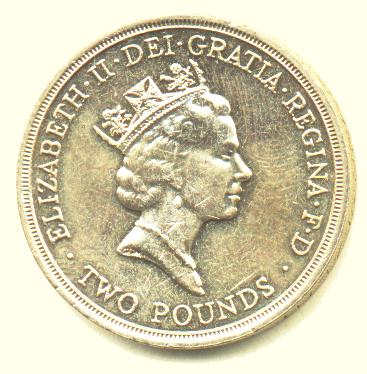
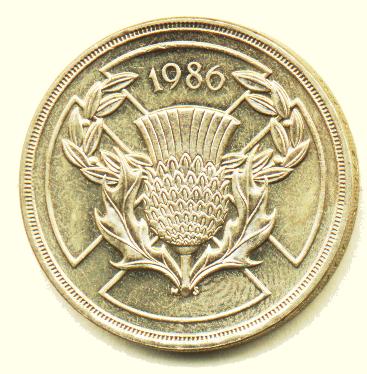
|
Commemorative £2 coins |
|
|
1986 |
Commonwealth
Games£ |
|
1989 |
Tercentenary
of the Bill of Rights 1689 |
|
1994 |
Tercentenary
of the Bank of England 1694 |
|
1995 |
50th
Anniversary of the end of World War 2 |
|
1995 |
50th Anniversary
of the United Nations |
|
1996 |
European
Football Championships |
The new £2 coin of 1997, on the other hand, was intended for general circulation from the outset. Unlike the earlier coins, all of which were made from nickel-brass, the new coins were bimetallic, with a central cupro-nickel inner disc bonded to an outer brass ring. It had a standard design, “Standing on the Shoulders of Giants”, which had four concentric circles showing progress from the Iron Age to the internet. In the late 1990's these coin sparked off a manic treasure hunt when a rumour spread that coins with the early reverse, which showed the queen wearing a necklace, were extremely rare and valuable. Some specimens changed hands for over £100 because of this baseless rumour.
In parallel with this, from 1999 onwards there was a series of commemorative designs, commencing with the Rugby World Cup that year, celebrated important events and significant anniversaries in British history.
|
Commemorative £2 coins |
|
|
|
1999 |
Rugby World
Cup (bi-metallic) |
|
|
2001 |
Centenary
of first radio message across the Atlantic by Marconi (bi-metallic) |
|
|
2002 |
XVIIth Commwealth
Games |
|
|
2003 |
Discovery
of DNA |
|
|
2004 |
Bicentenary
of Trevithick steam locomotive |
|
|
2005 |
400th Anniversary
of Gunpowder Plot |
|
|
2006 |
Isambard Kingdom Brunel
!806-1859 (2 designs) |
|
|
2007 |
Act of
Union between England and Scotland, 1717 |
|
|
2008 |
Olympic
Handover Ceremony |
|
|
2009 |
Birth of
Robert Burns, 1759 |
|
|
2010 |
Death of Fleoence Nightingale, 1910 |
|
|
2011 |
400th Anniversary
of King James Bible |
|
|
2012 |
Birth of
Charles Dickens, 1812 |
|
|
2013 |
London
Underground 1863 |
|
|
2014 |
Start of
World War 1, 1914 |
|
|
2015 |
800th
Anniversary of Magna Carta |
|
|
2016 |
350th Anniversary of the Great Fire of London,
1666 |
|
|
2017 |
Jane Austen |
|
|
2018 |
Centenary
of the end of World War 1 |
|
|
2019 |
Wedgewood |
|
|
2020 |
“Mayflower” |
|
The 50 pence coin was also issued for various commemorative issues. Although some were not intended for circulation, being included only in proof and uncirculated specimen sets, nonetheless many were commonly encountered in normal use. Initially there were three such commemoratives on the large initial design but after the introduction of the smaller version in 1997 these became a regular, though intermittent, part of normal coinage. The two biggest themes were those illustrating the characters made famous in the Beatrix Potter “Peter Rabbit” stories and those issued for the 2012 Olympic Games in London.
|
Early Fifty pence Commemorative issues |
|
|
1973 |
Britain's entry into EEC |
|
1992/1993 |
EEC Single Market |
|
1994 |
50th Anniversary of D-Day Landings in WW2 |
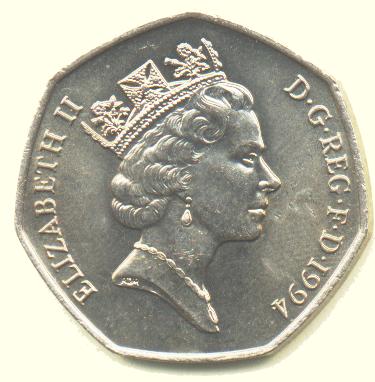
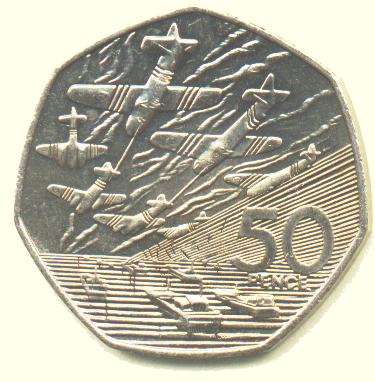
Fifty pence 1994
50th Anniversary of the D-Day Landings
By 1990, a combination of inflation and the realisation that the cupro-nickel coins were unnecessarily large, led to the five pence coin being reduced in weight and size, from 24mm diameter to 18mm. The ten pence coin followed in 1992, reduced down to a size similar to the old five pence but, to prevent fraudulent use of old five pence coins, particularly in cash machines, it was made slightly larger and heavier. In 1997 the last of the cupro-nickel coins, the fifty pence piece, suffered a similar fate, the new coin weighing only 8.1g instead of 13.5g.
An innovation in 1992, also the result of inflation, led to the minting of the one and two pence coins in copper plated steel instead of bronze. These coins could not function alongside the copper versions when used in slot machines, which is why these denominations can no longer be used for such a purpose.
28 March 2017 saw the introduction of a new twelve-sided bimetallic £1 coin to replace the round brass coin that had been in use since 1983. This was done because the old £1 had become the target of counterfeiters over the years, to the extent that the Treasury estimated one in every 30 of those in circulation was a forgery. The new coin includes a number of security features to make counterfeiting extremely difficult, including a circle of micro lettering next to the rim, ONE POUND on the obverse and the year of mintage on the other; there is also a small hologram beneath the sovereign’s head showing either £ or 1 depending on the angle viewed and the milling is only applied to alternate faces of the edge. The original £1 was demonetised later that year on 15 October.
NOTE: A large number of proof issues of decimal coins were struck in piedfort (meaning a much thicker than normal coin), and in silver and gold. None of these were ever intended for circulation.
Changes
and additions
Page
introduced 4 February 2002
Updated 2 September 2020